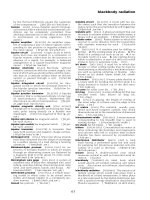Handbook of Lubrication Episode 1 Part 14 doc
Bạn đang xem bản rút gọn của tài liệu. Xem và tải ngay bản đầy đủ của tài liệu tại đây (678.42 KB, 16 trang )
Extrusion
Since the billet is pushed through the die (Figure 8), strength of the extruded product is
immaterial and attainable reduction is limited only by the strength of the container and punch.
In reverse or indirect extrusion the billet remains stationary in the container (Figure 8a),
and the magnitude of friction plays no role; die pressure p
e
is a function of extrusion ratio
R = A
o
/A
l
p
e
= σ
f
(a + b 1nR) (8)
where a and b are constants for a given die geometry.
In forward extrusion (Figure 8b), the stresses necessary to overcome friction add to the
die pressure, often limiting the length of billet that can be extruded.
When a lubricant is used, the die entry must be tapered to facilitate material flow along
the die face. Alternatively, one can extrude without any lubricant whatsoever; the die has
Volume II 323
FIGURE 7. Basic bar and tube drawing operations. (From Schey, J. A., Ed., Metal Deformation Processes:
Friction and Lubrication, Marcel Dekker, New York, 1970. With permission.)
FIGURE 8. Basic forms of extrusion. (From Schey, J. A., Ed., Metal Deformation Processes: Friction and
lubrication, Marcel Dekker, New York, 1970. With permission.)
317-333 4/10/06 12:59 PM Page 323
Copyright © 1983 CRC Press LLC
a flat face and the material, in seeking a minimum-energy path, shears at some angle
determined by the extrusion ratio. Material behind the shear surface forms a dead-metal
zone (Figure 8c).
To minimize friction in reverse extrusion of tubes, the container is kept as short as possible
and a short land is formed on the punch (Figure 8d). Lubricant between the workpiece and
punch end face must be gradually metered out to protect the freshly formed, highly extended
surfaces. The extrusion ratio and die pressures diminish as the punch diameter decreases.
With a small diameter, however, the process changes to indentation and punch pressures
can never be less than p = 3σ
f
. As with all inhomogeneous deformation, lubrication is
relatively ineffective in reducing punch pressure; nevertheless it is still desirable to prevent
metal pickup and punch wear.
Aspecial case is hydrostatic extrusion in which the extrusion pressure is supplied by a
high-pressure fluid; container friction is eliminated and die friction reduced but the cycle
time is long.
As in wire drawing, a high h/Lratio can lead to centerburst defects. In contrast to drawing,
friction increases the pressure in the deformation zone, reduces secondary tensile stresses,
and delays the onset of the defect.
Sheet Metalworking
Sheet metaiworking is always a secondary process on previously rolled flat products such
as sheet, strip and plate. The first such operation is usually shearing (or slitting, blanking,
or punching). Separation of adjacent metal parts occurs through highly localized plastic
deformation followed by shear failure (Figure 9a) and seems unaffected by friction. Never-
theless, lubrication is necessary to protect against rapid wear and die pickup. Many parts
are formed by bending, and bending forces are affected by friction when the workpiece
slides over some die element (Figure 9b).
Friction becomes extremely important when shapes of three-dimensional geometry are
formed through stretching, deep drawing, or their combination. In pure stretching the sheet
is firmly clamped (Figures 10a and b). In the absence of friction, thinning is most severe
and fracture occurs at the apex of the stretched part. With increasing friction, free thinning
over the punch nose is hindered and the fracture point moves further down the side of the
part.
In deep drawing (Figure 11), blanks of large diameter-to-sheet thickness ratio would
buckle (wrinkle) and must be kept flat by applying pressure through a blankholder. Frictional
stresses increase the force required for deformation, and when the force exceeds the strength
of the partially drawn product, fracture occurs. Friction must be minimized to reach the
maximum possible draw.
Cups of large depth-to-diameter ratio must be produced with several redrawing steps.
When the cup wall is to be reduced substantially, the drawn cup is pushed through an ironing
die, and wall thickness reduction takes place under high normal pressures and severe sliding,
calling for a much heavier-duty lubricant. Friction on the punch surface is again beneficial.
Many sheet metal parts in the automotive and appliance industries are of complex shapes
produced by simultaneous stretching and drawing. Lubrication is essential to prevent die
pickup and surface damage. To restrict free drawing-in of the sheet, a draw bead is incor-
porated (Figure 10b); this imposes severe conditions on the lubricant.
LUBRICATING MECHANISMS
Lubricants in deformation processes have to survive under an extremely wide range of
conditions. Interface pressures range from a fraction of flow stress σ
f
up to multiples of σ
f
(up to 4 GPa or 500 kpsi). Sliding velocities range from zero (at sticking friction) to 50
m/s (10,000 fpm) sometimes combined with approach velocities of up to 20 m/s (66 ft/sec).
324 CRC Handbook of Lubrication
317-333 4/10/06 12:59 PM Page 324
Copyright © 1983 CRC Press LLC
Layer-lattice compounds such as MoS
2
and graphite are effective if deposited in a continous
film. Their shear strength is also pressure-sensitive. In common with other solid films, they
cannot protect surfaces if the lubricant film breaks down.
Boundary Films
Very thin films formed on the die or workpiece may prevent adhesion and also reduce
friction. Extreme-pressure (EP) compounds rely on reactions that take place only if sufficient
time is available at temperature and if substrate composition is favorable. Contact time under
metalworking conditions is usually too brief, but if contact is repeated (as in cold heading,
wire drawing, sheet metal working, and sometimes rolling), reaction is possible with the
die.
Boundary films form almost instantaneously and are among the most important lubricants
for reactive metals, particularly aluminum, copper, and to a lesser extent, steel. Their shear
strength is pressure- and temperature-dependent. Breakdown at elevated temperatures limits
them to cold working.
Full-Fluid Film Lubrication
In this regime, tool and workpiece surfaces are separated by a liquid film of sufficient
thickness to avoid asperity interaction. Plastohydrodynamic theory can account for the effects
of process geometry, sliding speed, and lubricant properties in maintaining such a film. The
pressure and temperature sensitivity of viscosity must be considered, together with the
possibility of the lubricant becoming a polymer-like solid at higher pressures (Figure 12).
Mixed Lubrication
Inmost practical situations, only some portion of the total contact area is separated by a
thick lubricant film. Other parts of the contact area are in boundary contact, making boundary
or EPadditives a necessity in almost all metalworking fluids. Depending on process con-
ditions and lubricant viscosity, the deformed surface may be smoother than before defor-
mation. It may also be roughened by the formation of entrapped lubricant pockets.
Surface Roughness Effects
Although asperities piercing through the lubricant film can create adhesion problems, tool
and workpiece surfaces need not always be very smooth. To avoid skidding in rolling, the
roll surface is kept somewhat rough. Amoderately coarse, nondirectional (such as bead-
blasted) surface finish is desirable in maintaining graphite or MoS
2
supply in hot forging.
Asmooth, polished die surface is, however, desirable for liquid lubricants; any remaining
roughness is preferably oriented in the direction of material flow.
Moderate roughness of the workpiece surface helps carry liquid lubricants into the inter-
face, especially if the roughness is perpendicular to the direction of feeding. If sliding is
multidirectional, a random (bead-blasted) finish is preferable (as on automotive body sheets).
Lubricating Regimes
The range for various lubricating mechanisms is summarized in Figure 13. For an interface
pressure of p = σ
f
, friction cannot attain a value higher than that corresponding to sticking.
The presence of a solid film (other than metal) reduces the coefficient of friction to about
0.05 to 0.1, apparently irrespective of the nature of solid film. With a liquid, mixed lubri-
cation is attained once velocity and viscosity combine to sustain the pressures required for
plastic deformation. With increasing velocity and/or viscosity, the proportion of surface area
lubricated by the fluid film increases and the coefficient of friction drops to typically 0.03
to 0.05. True plastohydrodynamic lubrication is rare.
With increasing interface pressures, the apparent coefficient of friction drops even for
Volume II 327
317-333 4/10/06 12:59 PM Page 327
Copyright © 1983 CRC Press LLC
deformation makes the formulation of a single test technique virtually impossible. Standard
laboratory bench tests (such as the four-ball test) occasionally give successful correlation
with metal working practice; these cases are, however, exceptions and are perhaps fortuitous.
Most attractive are tests in which friction balance leads to a readily measurable change in
deformation. The ring compression test (Figure 4) is one which measures lubricant behavior
under normal contact to simulate forging. Forward slip (Equation 5), which directly reflects
friction balance in the roll gap gives similarly obvious results under rolling conditions.
Asecond group of test measures interface shear strength. Thus, a sheet drawing test
(Figure 14a) reveals the magnitude of friction under moderate pressures for light-duty sheet-
metalworking lubricants. Higher interface pressures and testing for lubricant durability are
possible using a hollow specimen with an annular end face pressed and rotated against a
flat anvil (Figure 14b); reasonable correlation is found with severe cold working such as
extrusion.
In a third group of tests, the magnitude of friction is judged from the force required to
perform deformation such as upsetting of a cylinder, extrusion, or wire drawing. Lubricant
ranking is made simply by comparing the magnitudes of forces.
No single test provides information for all conceivable metalworking conditions. For a
broader evaluation at least three tests have to be performed, such as ring compression for
normal approach, plane-strain compression for deformation with extensive sliding, and twist
compression for lubricant starvation situations. Die and workpiece material, surface prep-
aration and roughness, interface velocity, and entry zone geometry should be the same or
as closely scaled as possible to the actual process.
Testing forStaining
Lubricants are sometimes left on the deformed workpiece surface for corrosion protection,
and testing in typical industrial atmospheres is necessary. In other instances, the workpiece
is subjected to subsequent operations, such as annealing, joining, etc. Testing for staining
propensity can be done if air access is controlled to reproduce that typical of annealing in
coils.
Hot-Working Lubricants
Typical hot-working temperatures are in excess of 400°C for aluminum and magnesium
alloys, over 600°C for copper alloys, and over 900°C for steels and nickel-base alloys.
Lubricants are limited to those resisting the workpiece (or interface) temperature, such as
recommended in Table 1.
Oxides formed during heating the workpiece can fulfill a useful parting function, provided
they are ductile at the interface temperature. This condition is partially satisfied only by iron
oxides, cuprous oxide, and refractory metal oxides. Other harder oxides (such as ZnO) are
effective only when they can break up into a powdery form. Yet others (such as aluminum
and titanium oxides) are hard, brittle, cannot follow surface extension at all, and do not
protect once broken up.
Glasses of proper viscosity (typically 20 Pa·sec at the mean of the die and workpiece
surface temperatures) can act as true hydrodynamic lubricants. If the process geometry is
favorable (such as in extrusion), a thick glass mat may gradually melt off to provide a
continuous coating on the deformed product. Glass may be applied either as glass fiber or
powder to the die or hot workpiece, or in the form of a slurry with a polymeric bonding
agent to the workpiece prior to heating. In the latter case it may also protect from oxidation
and other reactions during the heating period.
Graphite is effective in forging steel or nickel-base alloys, if uniformly deposited on the
die surfaces from an aqueous or sometimes oily base. Wetting a hot surface is difficult but
special formulations (sometimes with polymeric binders) have been developed. Application
Volume II 329
317-333 4/10/06 12:59 PM Page 329
Copyright © 1983 CRC Press LLC
Volume II 331
Table 2
TYPICAL LUBRICANTS USED IN COLD WORKING
317-333 4/10/06 12:59 PM Page 331
Copyright © 1983 CRC Press LLC
332 CRC Handbook of Lubrication
Table 2 (continued)
TYPICAL LUBRICANTS USED IN COLD WORKING
Note:
a
Chlorine is the most effective EP agent on stainless steel.
b
Chlorine is avoided for Ti.
c
Sulfur is avoided for Ni because of reaction and for Cu because of staining.
d
Magnesium alloys are usually worked warm (above 200°C).
e
Usually conducted hot.
Hyphenation indicates that several components are used in lubricant. CL = chlorinated paraffin; EM = emulsion (the listed
lubricants are emulsified and 1 to 20% dispersed in water); EP = “extreme pressure” compounds (containing S, Cl, and/or P);
FA = fatty acids, alcohols, amines, and esters; FO = fats and fatty oils, e.g., palm oil, synthetic palm oil; GR = graphite: MO
= mineral oil (viscosity in units of centistoke [ = mm
2
/sec] at 40°C); PH = phosphate surface conversion; PC = polymer coating;
and SP = soap (powder, or dried aqueous solution, or as a component of an EM).
317-333 4/10/06 12:59 PM Page 332
Copyright © 1983 CRC Press LLC
for copper-base alloys, and is gaining some acceptance for steel rolling. Chemical solutions
(of rust preventatives, etc.) are often adequate when a protective oxide is present. The water
fulfills the important function of heat extraction.
Cold-Working Lubricants
The relatively low temperatures attained during cold deformation permit use of a wide
range of lubricants such as indicated in Table 2.
Solid films are of particular value for severe deformation. Although soft metals have
declined tin importance, tin on mild steel sheet is employed in the production of drawn and
ironed tin cans. Polymeric films, interposed as a separate film or deposited on the workpiece
surface, find growing but still limited application. Of greatest importance are surface con-
version coatings such as produced by phosphating of steel. They present a strongly adhering
film of sufficient porosity or surface detail to provide a mechanical key for the superimposed
lubricant layer, typically a soap. Film attachment is further enhanced by reacting the soap
with the phosphate film. Layer-lattice compounds are mostly used as additives to other
lubricants to provide a last defense in case of lubricant breakdown.
Oil-based lubricants represent a large proportion of the total used. The viscosity of natural
or synthetic oils is chosen to give mixed-film or occasionally almost full-fluid film lubrication,
but not so high to induce excessive surface roughening or to drop friction below an acceptable
limit. Because of the impossibility of avoiding all asperity contact, lubricants always contain
boundary additives: typically fatty acids, alcohols, esters, or natural fatty oils. When contact
is repetitive, EP additives may also be useful, particularly for metals (stainless steel, titanium)
on which fatty additives are ineffective. When conditions are unfavorable to developing
hydrodynamic films, grease may be used. Whenever cooling is important, the oil is applied
in a recirculating system. A flood of aqueous emulsions or dispersions is even more effective,
but staining may be a problem (e.g., on Al or Mg). Removal of wear particles by filtration
is an essential requirement in all recirculating systems.
REFERENCES
1. Bastian, E. L. H., Metalworking Lubricants, McGraw-Hill, New York. 1951.
2. Schey, J. A., Ed., Tribology in Mctalworking: Friction, Lubrication and Wear. American Society of
Metals, Metals Park. Ohio, 1983.
3. Tribology in Iron and Steel Works. Publ. No. 125, Iron and Steel Institute, London, 1969.
4. Rowe, G. W., Mech. Mach. Electr., 266, 20, 1972.
5. Schey, J, A., in Proc. Triboiogy Workshop Atlanta, F. F. Ling, Ed., National Science Foundation. Wash-
ington, D.C., 1974,428.
6. Schey, J. A., Introduction to Manufacturing Processes, McGraw-Hill, New York, 1977.
7. Wilson, W. R. D., in Mechanics of Sheet Metal Forming. Plenum Press, New York, 1978, 157.
8. Proc. 1st Int. Conf. Lubr. Challenges in Metalworking and Processing, IIT Research Institute, Chicago,
1978
9. Proc. 2nd Inst. Conf Lubr. Challenges in Metalworking and Processing. IIT Research Institute. Chicago,
1979
10. Schey, J. A., in Metal Forming Plasticity, Lippmann, H., Ed., Springer-Verlag, Berlin, 1979, 336.
11. Wilson, W. R. D., J. Appl. Metalworking. 1, 7, 1979.
12. Schey, J. A., in Proc. 4th Int. Conf. Prod. Eng., Japan Society of Precision Engineering, Tokyo, 1980,
102.
13. Kalpakjian, S. and Jain, S. C., Eds., Metalworking Lubrication. American Society of Mechanical En-
gineers, New York, 1980.
Volume II 333
317-333 4/10/06 12:59 PM Page 333
Copyright © 1983 CRC Press LLC
METALREMOVAL
Milton C. Shaw
INTRODUCTION
Agood deal of effort in the manufacture of hard goods is concerned with providing a
desired shape and accuracy to machine parts and the removal of material represents one
important way of doing this. The entire area of material removal may be divided into metal
cutting in which relatively large chips of uniform geometry arc formed and abrasive proc-
essing in which relatively small chips having a wide dispersion of geometries are produced.
It has been estimated that about 10% of the gross national product are spent in material
removal operations in the U.S. It is, therefore, important that such processes be understood
and efficiently performed if productivity (effective use of labor and capital) is to be achieved.
Since friction, wear, and lubrication play important roles in material removal operations, it
is pertinent to consider these operations here.
There are a wide variety of removal operations which use tools of different geometry and
kinematic relationship between tool and work. Some of the more important operations include
the following:
1.Turning to produce cylindrical surfaces
2.Milling to produce flat surfaces and surfaces of complex geometry
3.Drilling, boring, and reaming to produce round holes
4.Awide variety of grinding operations
In addition to these, there are a host of more specialized operations designed to do a particular
job more effectively or which are better suited to mass production. However, all removal
operations involve tools that penetrate the work to peel off unwanted material. What goes
on at the tip of these tools is essentially the same regardless of geometry or kinematics.
CUTTING MECHANICS
Orthogonal Machining
Figure 1 is a photomicrograph of a partially formed chip.
1
This was produced by moving
aworkpiece against a stationary two-dimensional tool, abruptly stopping the operation in
midcut and then sectioning and metallographically polishing the “hip root”. The magnified
view of the etched surface reveals a great deal concerning the action of a metal cutting tool
when removing a chip. As the material approaches line AB there is essentially no plastic
flow until AB is reached. At this point a sudden concentrated shear occurs and then the
material proceeds upward along the tool face with essentially no further plastic deformation.
In the case of Figure 1, the cutting edge was stationary and straight, extending perpendicular
to the plane of the paper. This is called orthogonal cutting since the cutting edge is per-
pendicular to resultant velocity vector (V) which is in the horizontal direction in Figure 1.
Merchant
2
and Piispanen
3
first discussed orthogonal cutting in fundamental terms.
Figure 2 is a diagrammatic representation of Figure 1. Line AB is the trace of the surface
on which the concentrated shearing action occurs and is called the shear plane. The angle
the shear plane makes with velocity vector (V) is the shear angle (φ) while the angle between
the face of the tool (rake face) and the normal to the velocity vector is called the rake angle
(α). Also shown in Figure-2 is the clearance angle (γ). The thickness of the layer removed
is the undeformed chip thickness (t) and the width of cut perpendicular to the paper will be
Volume II 335
335-356 4/11/06 12:33 PM Page 335
Copyright © 1983 CRC Press LLC
fractures internally in shear leaving behind the stationary body of metal attached to the tip
of the tool (BUE). Another reason is associated with the fact that metals (notably steel)
exhibit minimum ductility (strain at fracture) somewhat above room temperature. This is
called “blue brittleness”, since the minimum strain-at-fracture temperature for steel cor-
responds to that where the thickness of surface oxide produced gives rise to a blue interference
color. At relatively low-cutting speeds (low-tool face temperature), the temperature along
CD will be closer to the blue brittle temperature than along AC and then the strain at fracture
along CD will be less than along AC.
The inherent instability of a large BUE is very troublesome relative to surface finish. As
cutting proceeds, BUE tends to grow slowly until it reaches a critical size and then it leaves
abruptly with the chip. Since the BUE grows downward as well as outward (point D below
A in Figure 4), the surface produced by the periodic change in size of the BUE is as shown
in Figure 4. This is one of the sources of surface roughness when cutting at relatively low
speed. An unstable BUE can also decrease tool life due to abrasive action of pieces of BUE
on the tool face and wear land; on the other hand, a small, stable BUE can be beneficial in
protecting the tip of the tool from wear.
The most important way of avoiding a BUE is to increase cutting speed. Above a certain
Volume II 337
FIGURE 3. Photomicrograph showing
large BUE and portions of BUE along
finished surface and along face of chip.
AISI 1020 steel cut dry at 90 fpm (27.4
m/min). Undeformed chip thickness =
0.005 in. (0.125 mm).
FIGURE 4. Diagrammatic representation of Figure 3 showing BUE-
induced roughness on finished surface.
335-356 4/11/06 12:33 PM Page 337
Copyright © 1983 CRC Press LLC
cutting speed (~ Im/sec or 200 ft/min) a large unstable BUE will not tend to form. Another
way of decreasing BUE formation is to increase the rake angle of the tool. This causes angle
DCAin Figure 2 to approach 0° and hence CD to become parallel to AC in Figure 4. On
the other hand, making the effective rake angle more negative will tend to promote the
formation of a BUE.
Regions of Importance
Figure 5 identifies four regions of importance in cutting operations. Region Aconcerns
the shear process associated with chip formation by concentrated shear. Region B involves
friction-like behavior along the tool face. Region C concerns action on the clearance face
of the tool while region D concerns the characteristics of the finished surface.
Cutting Forces
By mounting the workpiece on a dynamometer, it is possible to measure cutting forces
in the direction of the velocity vector (F
P
) and in two orthogonal directions to V– F
Q
in
the plane of the paper and F
R
perpendicular to the plane of the paper (Figure 6). In orthogonal
cutting F
R
= 0. Figure 7 is a free body diagram of an orthogonal chip produced under
steady-state conditions as a free body. Only two forces act on this free body — R (between
chip and tool) and R′(between chip and work). These must be equal in magnitude and
oppositely directed. This very important result explains the strong interaction observed
between what happens on the tool face and what happens on the shear plane. Both the
processes on the shear plane and tool face must be studied at the same time; it is very
difficult to identify cause and effect in interpreting metal cutting data.
338CRC Handbook of Lubrication
FIGURE 5. Regions of importance in metal cutting.
FIGURE 6. Forces acting on tool for orthogonal cut.
335-356 4/11/06 12:33 PM Page 338
Copyright © 1983 CRC Press LLC
(5)
The value of mean chip thickness in Equation 4 is not easily measured directly because
most chips are relatively rough on the free surface. Amore convenient method of obtaining
r is from the chip length ratio (ᐉ
c
/ᐉ). When any material is deformed plastically there is a
negligible change in volume. Hence,
(6)
where the quantities ᐉ, b, and t without subscripts are the length, width, and depth of the
undeformed chip while subscript (c) indicates corresponding quantities in the deformed chip.
From Equation 6
(7)
Since in most cases b
~
–
(10 t), chips are formed under essentially plane strain conditions
which means there will be negligible side flow and
b ~
=
b
c
(8)
Cutting ratio (r) and shear angle (φ) play a very important role in metal cutting. In general,
as shear angle (φ) increases, the area of the shear plane (A
s
) decreases and hence the energy
consumed on the shear plane decreases. Thus, the cutting ratio is a convenient measure of
the efficiency — the larger the cutting ratio (r) the more efficiently the cutting operation is
being performed from the point of view of the energy expended. An increase in cutting ratio
may be accomplished by a change in workpiece chemistry or structure, or by a decrease in
friction on the tool face.
ShearStrain in Chip Formation
Figure 9 shows an idealized model of the cutting process involving the previously described
concentrated shear mechanism. Active shear planes which contain one or more imperfections
are relatively far apart (compared with atomic spacing) and, therefore, the basic chip forming
process may be approximated by a deck of cards sliding over each other as they cross the
shear plane (Figure 9a). Figure 9b shows how the shear strain in cutting may be approximated
as follows:
340 CRC Handbook of Lubrication
FIGURE 8. Construction for use in deriving expres-
sion connecting shear angle (φ) and cutting ratio (r).
335-356 4/11/06 12:33 PM Page 340
Copyright © 1983 CRC Press LLC
(Figure 10a)(11)
(Figure 10b)(12)
As already mentioned slip does not occur on every atomic plane but only on bands of
planes in the vicinity of a defect. This results in the strain in a chip being very inhomogeneous,
being small within a slip band and large between. It also results in the strain rate of chip
formation being very large since
(13)
where Δy is the width of a slip band which is normally about 10
–4
in. (25 × 10
–4
mm).
For example, for a moderate cutting speed of 100 fpm (0.5 m/sec), a rake angle (α) of 0°,
a shear angle (φ) of 20°, and Δy = 10
–4
in. (2.5µm), the strain rate is found to be
approximately 0.2 × 10
6
/sec. This is recognized as a very high value when it is realized
that the strain rate in an ordinary tensile test is about 10
–3
/sec.
The strain in cutting not only takes place at a high strain rate but also at high temperature.
However, these two items have opposite effects on flow stress and it is generally considered
that the flow stress of material being cut at high speed is not very different than that for a
specimen tested at an ordinary strain rate and room temperature.
Specific Cutting Energy
The concept of energy per unit volume (specific energy) is a useful one here as it is in
other areas of mechanics. The total specific energy (u) is
(14)
where (Vbt) is the volume rate of material removal. The specific cutting energy (u) has only
two significant components — u
s
, specific shear energy, and u
F
, specific friction energy,
where
(15)
(16)
Since specific surface energy and specific momentum energy are negligible, in all metal
removal operations including grinding
u= u
s
+ u
F
(17)
In metal cutting operations, the main variables influencing specific energy (u) are work-
piece chemistry and hardness. Values of u given in Table 1 are useful in estimating the
power component of cutting force (F
p
) as well as the power required for a specific cutting
operation. The component of the feed force may be estimated to a first approximation by
assuming it to be half the value of F
P
.
342 CRC Handbook of Lubrication
335-356 4/11/06 12:34 PM Page 342
Copyright © 1983 CRC Press LLC
total energy involved in metal cutting is distributed approximately as follows: 3/4 on shear
plane and 1/4 on tool face.
Values of strain thatare several times larger than those involved in ordinary materials
tests are possible without gross fracture of the chip due to the fact that a very large normal
stress is present on the shear plane. However, it is believed that microcracks of limited
extent do form on the shear plane when cutting with a continuous chip and that the formation
and rewelding of these microcracks plays an important role in the mechanism of concentrated
plastic shear strain that occurs on the shear plan.
Three-Dimensional Cutting
The foregoing discussion is concerned with orthogonal cutting in which a straight cutting
edge thatextends normal to the cutting speed vector produces the chip. If the cutting edge
has an angle to Vother than 90°, the deviation from 90° is referred to as the inclination
angle. The main influence an inclination has is to cause the chip to flow up the tool face
atan angle other than 90° to the cutting edge. This has the effect of cutting with a larger
positive rake angle without a corresponding reduction in the included angle at the tool tip
with its attendant weakening effect. The result of the larger effective rake angle is to decrease
cutting forces and energy and to reduce the size of the BUE. In all other respects the
performance of three-dimensional tools is the same as two-dimensional tools. An example
of a three-dimensional cutting tool is the face milling cutter shown in Figure 11. In this case
the inclination angle is the helix angle of the cutting edge.
344 CRC Handbook of Lubrication
Table 2
REPRESENTATIVE VALUES
335-356 4/11/06 12:34 PM Page 344
Copyright © 1983 CRC Press LLC
1. High speed steels (HSS)
2. Sintered tungsten carbide (WC)
3. Sintered titanium carbide (TiC)
4. Sintered aluminum oxide (ceramic)
5. Sintered cubic boron carbide (CBN)
6. Sintered and single-crystal diamond tools (D)
As we proceed down the list, these materials are harder but more brittle. In general, if
chipping of the cutting edge is a problem (which normally occurs as the tool finishes a cut
rather than when it is beginning a cut), it is necessary to move upward in the list. This is
done reluctantly, however, since the resulting tool has a lower resistance to attritions and
abrasive wear.
There are several varieties of HSS and WC tools that have varying degrees of wear and
shock resistance. As the wear resistance increases, however, shock resistance generally
decreases. As vanadium and cobalt content increases in HSS tools, they become more wear
resistant but more difficult to grind. The shock resistance of WC tools is increased by
increasing the cobalt content while crater resistance is increased by substituting TiC, TaC,
or CbC for some of the WC or by use of a thin (0.0002 in. or 5 µm) coating of TiC, TaC,
or Al
2
O
3
on a carbide substrate.
Certain tool materials are chemically incompatible with certain work materials. For ex-
ample, poor results are obtained if ceramic (A1
2
O
3
) tools are used to machine titanium or
aluminum alloys. This is because strong bonds tend to form between the work material
(chip) and the oxide tool. Similarly, poor tool life results are obtained when a diamond tool
is used to machine steel. The high temperature iron on the face of the tool lends to dissolve
carbon from the diamond tool faces in this case. CBN gives much better results for ferrous
work materials. Diamond tools are used primarily to machine nonferrous materials such as
aluminum and copper base alloys.
Taylor Tool Life Equation
Tool life (T) measured in minutes is generally found to vary with cutting speed (V) in
346 CRC Handbook of Lubrication
FIGURE 12. Types of fool wear depending on value
of product (Vt
0.6
).
335-356 4/11/06 12:34 PM Page 346
Copyright © 1983 CRC Press LLC
accordance with the following equation initially suggested by Taylor
7
VT
n
= C(21)
where n and C are empirical constants depending upon tool and work materials and the
undeformed chip thickness (t) which are held constant in Equation 21. Representative values
for n are given in Table 3. Thus, for a high-speed steel tool, tool life T~ V
10
and from
Equation 20a T~ θ
20
. This suggests that the major cause for the strong dependance of tool
life (T) on cutting speed (V) is due to tool temperature (θ).
By use of Equation 20a, the Taylor equation may be generalized as follows for cases
where both Vand t vary
(22)
where n
2
> n
1
. This equation may in turn be generalized to include a variable depth of cut
(b) as follows:
(23)
where n
1
< n
2
< n
3
. Typical values for n
1
, n
2
, and n
3
, for a high-speed steel single-point
cutting tool are 0.10, 0.17, and 0.25, respectively.
WearLand Tool Wear
Wear land tool wear (Figure 12c) is probably the most important type of wear for single-
point tools that are well matched to the material being machined. When the extent of the
wear land is plotted vs. cutting time at a constant rate of metal removal, curves such as
those shown in Eigure 13 are obtained. Wear rate is high at the beginning and at the end
of the test.
8
CraterWear
The volume of wear that may be tolerated on the wear land is very much less than on
the tool face. This is fortunate since the temperature on the tool face is very much higher
and hence the volume rate of wear is much higher on the tool face. The maximum temperature
on the tool face which occurs at about the midpoint of the contact length between chip and
tool is usually sufficient to give thermal softening and a relatively large real area of contact
for the tool face. The crater that forms has its maximum depth at the point of maximum
temperature and, hence, the crater develops as shown in Figure 14, with its maximum point
at approximately a constant distance from the cutting edge. The rate of crater formation
depends on the stability of the constituents of the tool, the rate of diffusion of the products
of decomposition, and their influence on the strength of the work material.
When a tungsten carbide tool is used to cut a low-carbon steel, the rate of crater formation
Volume II 347
Table 3
REPRESENTATIVE
VALUES OF TAYLOR
EXPONENT (n)
335-356 4/11/06 12:34 PM Page 347
Copyright © 1983 CRC Press LLC









